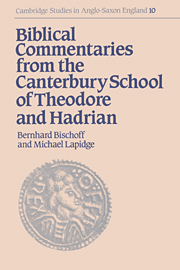Book contents
- Frontmatter
- Contents
- Preface
- List of abbreviations
- 1 Introduction
- 2 Archbishop Theodore
- 3 Abbot Hadrian
- 4 Theodore and Hadrian in England
- 5 The sources of the Canterbury biblical commentaries
- 6 The nature of the Canterbury biblical commentaries
- 7 The manuscripts
- Texts and translations
- Commentary to the texts
- Appendix I Additional manuscript witnesses to the Milan biblical commentaries
- Appendix II Two metrological treatises from the school of Canterbury
- Fig. 1 Cilicia and Syria
- Fig. 2 Constantinople in the seventh century
- Fig. 3 Churches and monasteries of seventh-century Rome
- Fig. 4 Cyrenaica and the Pentapolis
- Fig. 5 Campania and the Bay of Naples
- Fig. 6 Palestine
- Bibliography
- Index of Old English words quoted in the texts
- Index of Greek words quoted in the texts
- Index of names cited in the texts
- General index
4 - Theodore and Hadrian in England
Published online by Cambridge University Press: 08 January 2010
- Frontmatter
- Contents
- Preface
- List of abbreviations
- 1 Introduction
- 2 Archbishop Theodore
- 3 Abbot Hadrian
- 4 Theodore and Hadrian in England
- 5 The sources of the Canterbury biblical commentaries
- 6 The nature of the Canterbury biblical commentaries
- 7 The manuscripts
- Texts and translations
- Commentary to the texts
- Appendix I Additional manuscript witnesses to the Milan biblical commentaries
- Appendix II Two metrological treatises from the school of Canterbury
- Fig. 1 Cilicia and Syria
- Fig. 2 Constantinople in the seventh century
- Fig. 3 Churches and monasteries of seventh-century Rome
- Fig. 4 Cyrenaica and the Pentapolis
- Fig. 5 Campania and the Bay of Naples
- Fig. 6 Palestine
- Bibliography
- Index of Old English words quoted in the texts
- Index of Greek words quoted in the texts
- Index of names cited in the texts
- General index
Summary
Theodore arrived in England on Sunday 27 May 669, a year to the day after he had set out from Rome (HE IV.2), and Hadrian arrived the following year. We can scarcely imagine their first impressions of England, though the sight of tiny wooden churches dotting the landscape must surely have evoked memories in Theodore of Hagia Sophia and Hagia Eirene in Constantinople, and in Hadrian of St Restituta and the Stephania in Naples, and in both of them of the great basilican churches in Rome. Nevertheless they set determinedly and expeditiously about reconstructing the administrative organization – if not the architectural fabric – of the English church. Their first undertaking was, as Bede tells us, a visitation of those parts of the island inhabited by the English (HE IV. 2: peragrata insula tota, quaquauersum Anglorum gentes morabantur). During this tour, Bede goes on to say, they gave instruction in the ‘correct’ manner of the Christian life (rectum uiuendi ordinem) and in the ‘canonical’ custom of celebrating Easter (ritum celebrandi paschae canonkum). We shall consider the literary evidence for Theodore's concern with orthodox belief and canon law shortly, but it may be helpful to preface those considerations with a very brief account of the administrative arrangements he made to effect the resuscitation and reconstruction of his new archdiocese.
ECCLESIASTICAL ADMINISTRATION
When Theodore arrived, his own see had been vacant for nearly five years, and there were similar vacancies in episcopal sees in the kingdoms of Mercia, Wessex and East Anglia. Indeed the only three bishops in office in the whole country were Wini, bishop of London, Ceadda, bishop of York, and Wilfrid, bishop of Ripon.
- Type
- Chapter
- Information
- Publisher: Cambridge University PressPrint publication year: 1995

